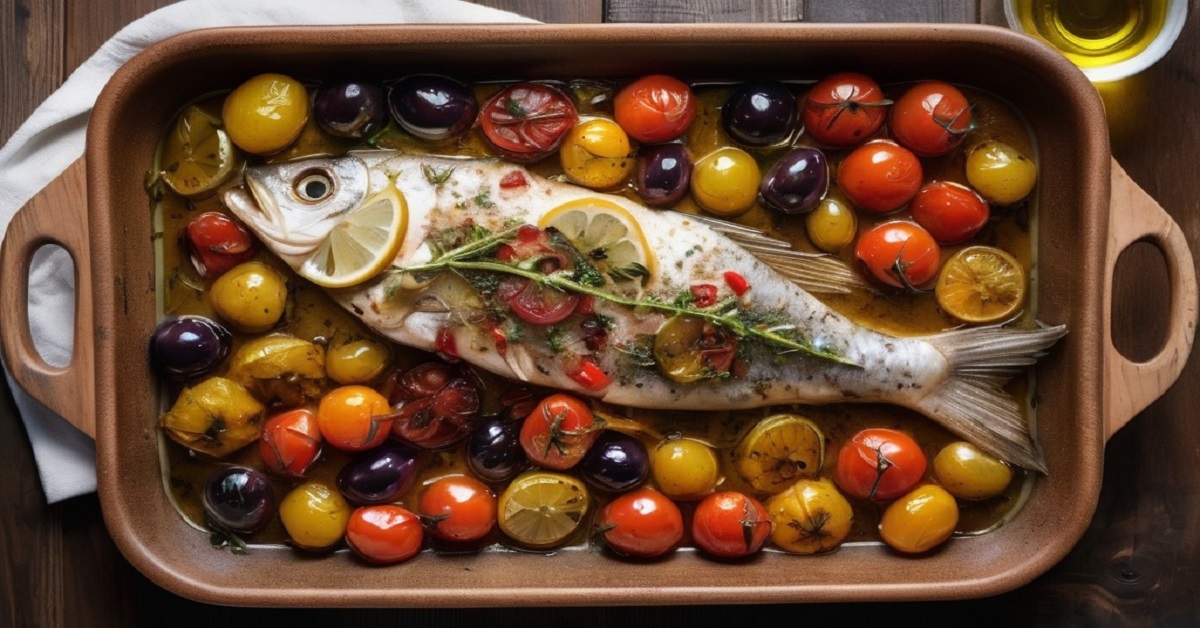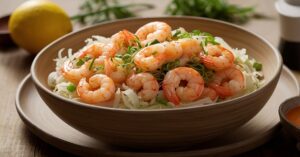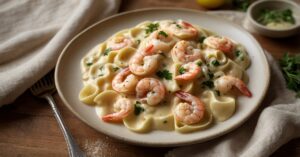The Best Mediterranean Baked Fish Recipe starts like this: Ever pulled a bubbling tray of baked fish out of the oven and thought, “Well, that smells like regret?” Yeah, me too. Once, in a sleepy coastal town near Valencia, I overcooked a whole sea bream so badly the waiter offered me a drink “on the house, for the funeral.” Never again.
That’s when I went all in on Mediterranean fish. Not just how to bake it, but how to do it right.
This is the recipe I kept coming back to tweaking, refining, burning (sometimes on purpose), until it was perfect. It’s more than just fish with a slice of lemon. It’s a panful of history, sun-drenched herbs, juicy tomatoes, and the salty slap of the sea.
What This Dish Is All About?
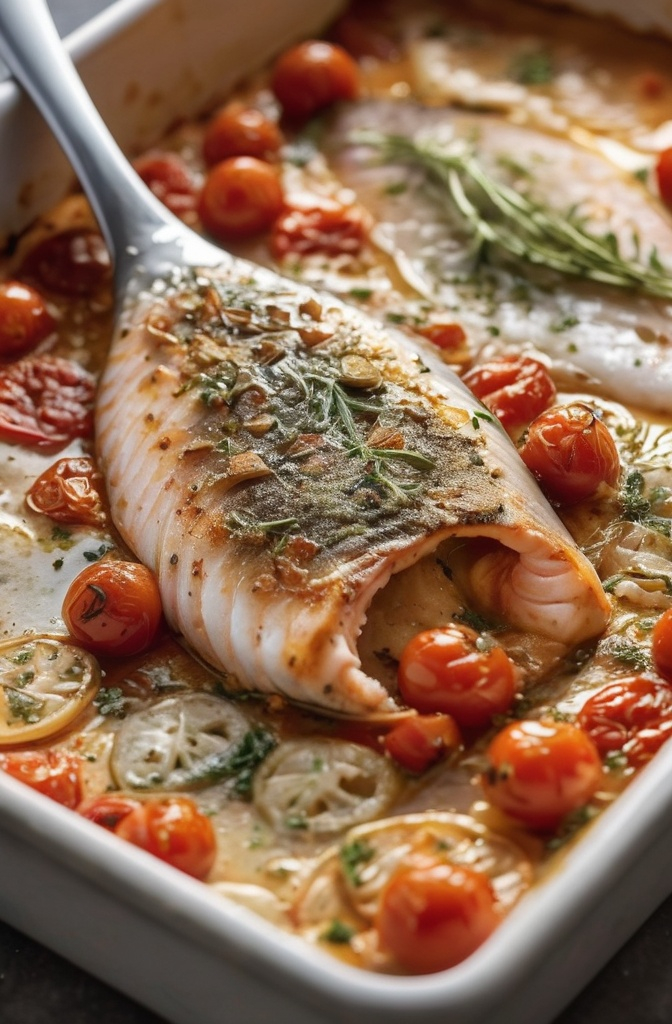
We’re talking about Mediterranean Baked Fish typically a white, flaky fish, gently roasted with fresh vegetables, good olive oil, lemon, herbs, and often a kiss of garlic. What makes it special? It’s the kind of dish that’s deceptively simple but rewards you for every little detail you get right. Timing. Ingredient quality. Oven temperature. Fish freshness.
And the big one: restraint. This isn’t a dish to drown in cream or cheese. Let the fish speak. Let the tomatoes burst and the olives surprise. The Mediterranean way is clean, fresh, balanced. That’s what we’re aiming for.
Ingredients & Substitutions
Let’s start with the good stuff. These are listed in the order they go in the dish.
- White fish fillets (600g / ~1.3 lbs): Sea bass, snapper, cod, or hake. Skin-on or off, your call. I prefer skin-on if roasting uncovered.
- Substitutes: Tilapia for budget, halibut for luxury. Frozen works if thawed properly, but fresh really is better here.
- Cherry tomatoes (2 cups): They burst and sweeten everything.
- Substitute: Regular tomatoes cut into chunks, but you’ll miss that juicy pop.
- Red onion (1, thinly sliced): Sweetens as it roasts.
- Garlic (3–4 cloves, sliced thin): Don’t mince it. You want mellow roasted garlic, not raw bite.
- Kalamata olives (handful, pitted): Add that punch of brine.
- Substitute: Capers, green olives, or anchovy bits.
- Lemon (1 whole, half sliced, half juiced): Sharpens and brightens.
- Extra virgin olive oil (3 tbsp): The good kind. Peppery is nice.
- Fresh herbs: Parsley, thyme, oregano. A small handful total.
- Substitute: Dried herbs are okay, but cut the quantity in half.
- Sea salt & cracked black pepper: Don’t skimp.
- White wine (optional, 1/4 cup): For steam and a tiny bit of funk.
- Substitute: Water + a splash of vinegar, or skip.
For dietary needs: gluten-free by default, dairy-free, and adaptable to low FODMAP if you skip onions and garlic (use chives instead).
Step-by-Step Instructions
1. Preheat your oven to 400°F (200°C).
Hot, but not blistering. You want roast, not incinerate.
2. Prep the base.
In a large baking dish or sheet pan, toss cherry tomatoes, onion slices, garlic, olives, and half the lemon slices. Drizzle with half the olive oil and a pinch of salt. Spread it out into a bed. This is your flavor mattress.
3. Lay the fish fillets on top.
Pat them dry first moisture is the enemy of crisp. Nestle them in. Give ‘em a tiny massage with the rest of the olive oil, the lemon juice, and your herbs. Season with salt and pepper. Lay a couple lemon slices directly on top of the fish.
4. Add the wine (if using).
Pour it into the corners of the pan, not on the fish. You’re steaming, not drowning.
5. Bake uncovered for 15–20 minutes.
Timing depends on thickness. Rule of thumb: 10 minutes per inch of thickness, but check at 15. Fish should flake easily, but still glisten. Don’t wait for it to “look cooked” by then it’s dry.
Expert tip:
If the tomatoes and onions aren’t getting enough color, broil for 2 minutes at the end. Watch it like a hawk. Burnt garlic is a dish killer.
Common mistakes to avoid:
- Overcrowding the pan. Space is flavor.
- Using too much liquid. This ain’t soup.
- Under-seasoning. White fish needs a good amount of salt to taste like anything.
Variations:
- For a spicy kick, add a few thin slices of fresh chili or a pinch of chili flakes with the herbs.
- Want something more rustic? Add thin-sliced potatoes under the tomatoes. Roast them 10 mins before the fish goes in.
Cooking Techniques & Science
Baking fish with the vegetables underneath serves two purposes. One, it protects the delicate protein from overcooking on the hot metal. Two, the fish absorbs aromatic steam while its juices drip down, flavoring the veggies. That’s flavor economics.
The science of not overcooking fish is real. At around 140°F (60°C), the collagen in fish begins to break down, letting it flake. Go past 150°F (65°C), and you’re heading into dry territory. A meat thermometer isn’t overkill it’s smart.
Olive oil here isn’t just fat it’s structure. It helps transfer heat and delivers flavor evenly. Cold-pressed oils from early harvest olives? Peppery, almost bitter. Later harvest oils? Mellow, buttery. Choose your mood.
Use a ceramic or glass dish if you want even, gentle baking. Metal sheet pans will brown edges faster. For larger gatherings, go sheet pan.
Serving & Pairing Suggestions
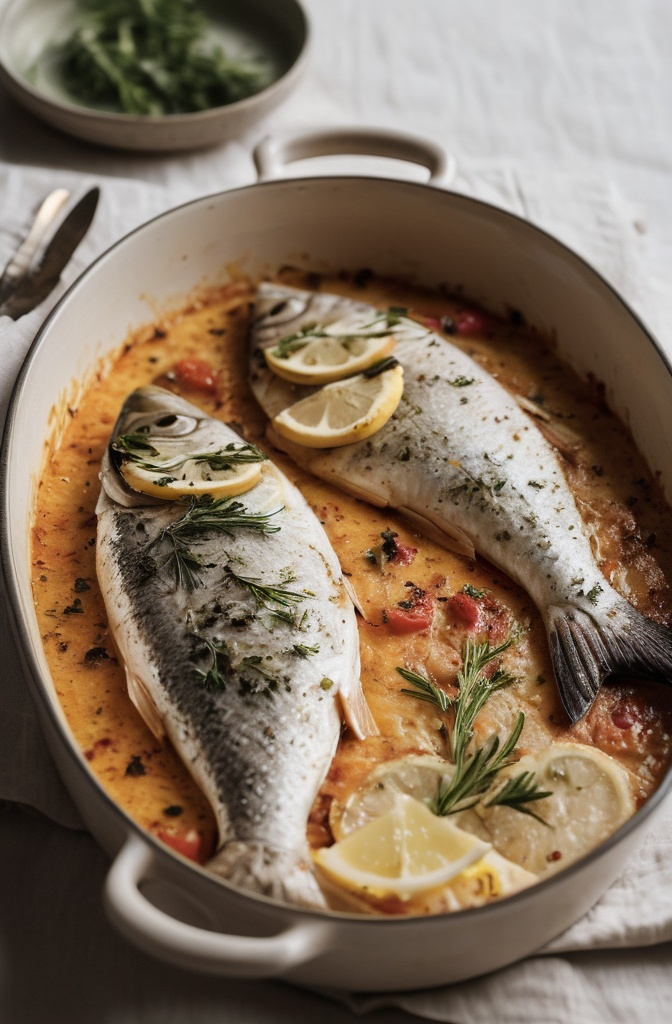
This dish loves to be shared. Serve straight from the baking dish, family-style, with a big serving spoon and zero apology. Scoop up fish, scoop up the roasted veg, drizzle any pan juices on top.
Plating for fancy folks? Lay the fish over a smear of hummus or roasted red pepper puree. Top with a few fresh herbs and a micro drizzle of olive oil.
What to serve with it:
- Crusty bread to mop up the juices. Or grilled pita.
- A chilled white wine Vermentino, Albariño, or a dry Greek Assyrtiko.
- A green salad with lemon vinaigrette. Or roasted fennel if you’re feeling fancy.
- For carbs, couscous or lemony orzo work great.
FAQs
1. What’s the best type of fish for Mediterranean baking?
Sea bass, snapper, or cod are top choices. Go for something firm, mild, and white-fleshed. Avoid oily fish like salmon it doesn’t suit the style.
2. Can I use frozen fish?
Yes, just make sure it’s fully thawed and dried with a paper towel. Ice crystals will ruin the texture.
3. How do I know when the fish is done?
It should flake easily with a fork and be opaque but still juicy inside. If using a thermometer, aim for 140–145°F (60–63°C).
4. Can I make this in advance?
You can prep the veg base ahead, but bake the fish fresh. Reheating dries it out.
5. What if I don’t like olives?
Skip them or use capers. You want a briny contrast so something sharp and salty.
Conclusion: Why This Dish Matters
This Mediterranean Baked Fish is not just a recipe. It’s a reminder of how little you need to make something great. Good fish, sharp knife, the courage to not overdo it. That’s it.
The best version of this dish will always come from what’s fresh, not what’s fancy. A cheap tomato in winter won’t cut it. A fish left out too long will betray you. But when everything is right when the herbs are bright, the lemons are thin, and the fish flakes like butter it sings.
Final tip? Let it rest for 3 minutes out of the oven. It finishes cooking gently and soaks up its own juices. That’s the chef’s secret.
Don’t skip that step.


